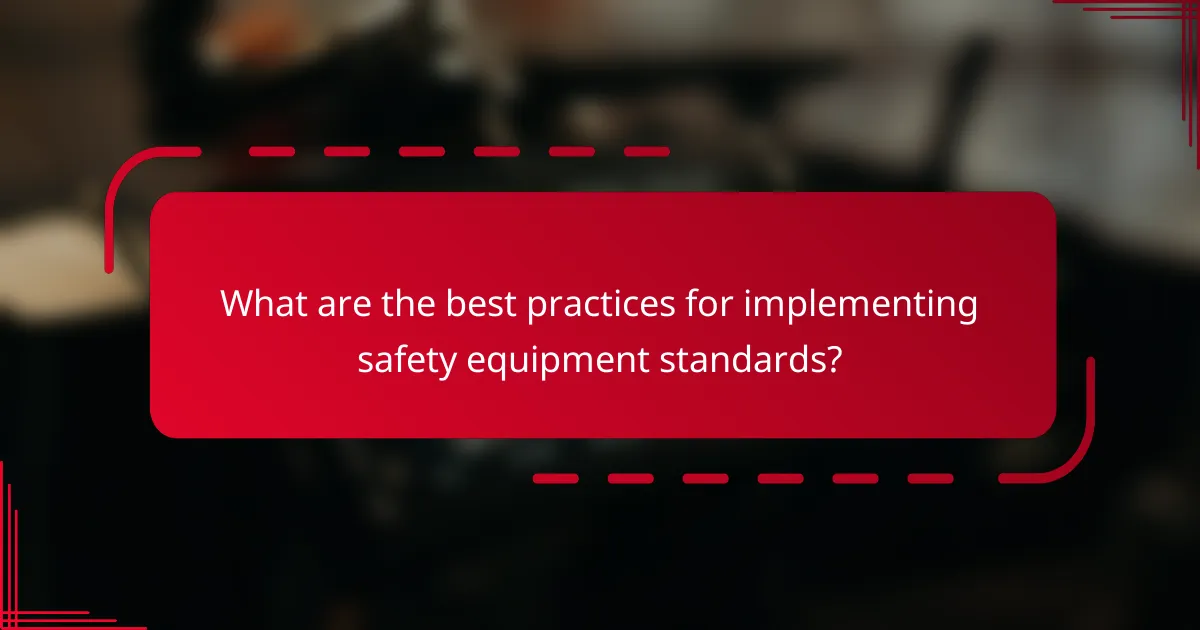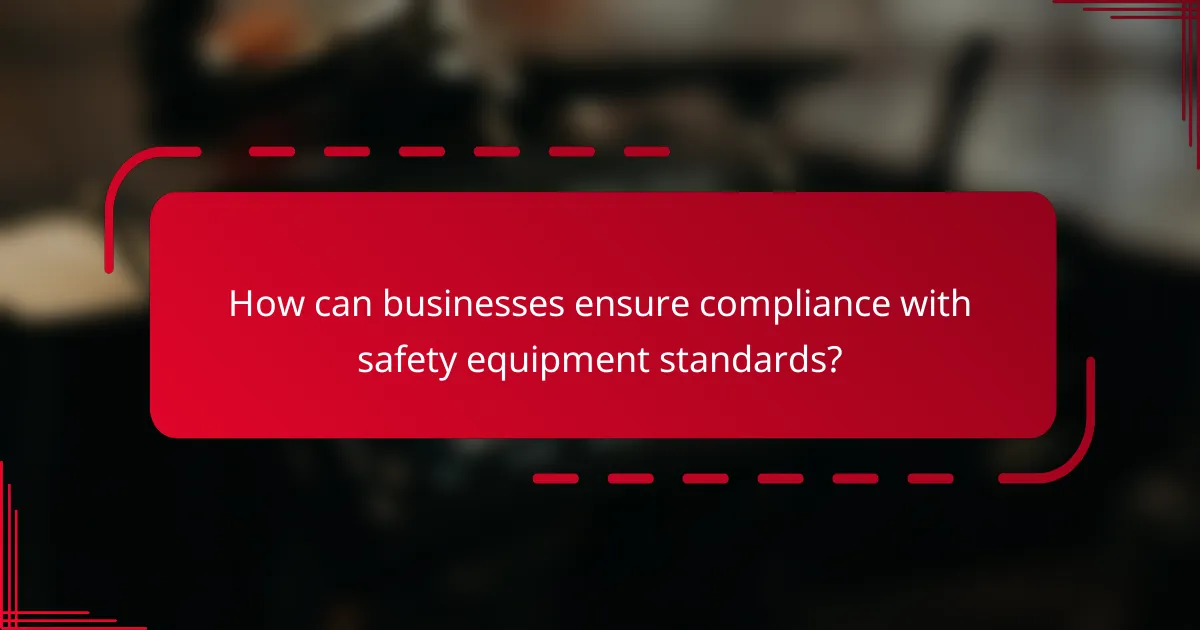Safety equipment standards play a vital role in ensuring workplace safety across various industries in the United States. Established by multiple organizations, these regulations encompass a wide range of equipment, from personal protective gear to machinery safety, and are essential for compliance and risk management. Understanding the specific standards applicable to different sectors is crucial for protecting workers and maintaining a safe working environment.

What are the key safety equipment standards in the United States?
The key safety equipment standards in the United States include regulations and guidelines established by various organizations to ensure workplace safety. These standards cover a range of equipment, from personal protective gear to machinery safety, and are crucial for compliance and risk management.
OSHA regulations
The Occupational Safety and Health Administration (OSHA) sets forth regulations that mandate the use of safety equipment in various industries. Employers must provide appropriate personal protective equipment (PPE) to workers, ensuring it meets specific performance criteria.
Common OSHA regulations include requirements for hard hats, safety goggles, and hearing protection. Non-compliance can lead to fines and increased liability, making it essential for businesses to stay informed about OSHA standards relevant to their operations.
ANSI standards
The American National Standards Institute (ANSI) develops consensus standards that enhance safety equipment performance and reliability. ANSI standards cover a wide range of safety gear, including eye and face protection, fall protection, and respiratory protection.
For instance, ANSI Z87.1 outlines requirements for eye protection, ensuring that products can withstand impact and provide adequate optical clarity. Adhering to ANSI standards not only improves safety but also helps organizations demonstrate compliance with OSHA regulations.
NIOSH guidelines
The National Institute for Occupational Safety and Health (NIOSH) provides guidelines for the selection and use of respiratory protective equipment. NIOSH evaluates and certifies respirators, ensuring they meet rigorous performance standards for various hazardous environments.
Employers should refer to NIOSH recommendations when selecting respirators, considering factors such as the type of contaminants present and the required protection level. Proper training on the use and maintenance of these devices is also critical to ensure worker safety.
ASTM specifications
The American Society for Testing and Materials (ASTM) develops specifications that outline the performance criteria for safety equipment. These specifications help manufacturers produce reliable products that meet safety needs across different industries.
For example, ASTM F2413 specifies performance requirements for protective footwear, including impact resistance and slip resistance. Adopting ASTM specifications can enhance product quality and reduce the risk of workplace injuries.
ISO certifications
The International Organization for Standardization (ISO) provides global standards that can enhance safety equipment quality and interoperability. ISO certifications, such as ISO 9001 for quality management systems, help organizations ensure their safety equipment meets international benchmarks.
While ISO standards are not mandatory in the U.S., obtaining ISO certification can improve marketability and demonstrate a commitment to safety and quality. Companies may benefit from aligning their safety practices with ISO standards to enhance their reputation and operational efficiency.

How do safety equipment standards compare across different industries?
Safety equipment standards vary significantly across industries, reflecting the unique risks and requirements of each sector. Understanding these differences is crucial for ensuring compliance and protecting workers effectively.
Construction industry standards
In the construction industry, safety equipment standards focus on protecting workers from falls, heavy machinery, and hazardous materials. Common regulations include the use of hard hats, safety harnesses, and high-visibility clothing, often guided by OSHA regulations in the United States.
Employers should conduct regular safety training and ensure that all equipment meets the latest ANSI standards. Regular inspections of safety gear can prevent accidents and ensure compliance with local regulations.
Manufacturing industry standards
Manufacturing safety standards prioritize protection from machinery hazards, chemical exposure, and ergonomic risks. Equipment such as gloves, goggles, and ear protection are essential, with guidelines often set by organizations like ANSI and ISO.
Employers must assess workplace risks and provide appropriate personal protective equipment (PPE) tailored to specific tasks. Regular training and maintenance checks are critical to maintaining a safe working environment.
Healthcare industry standards
In healthcare, safety equipment standards emphasize infection control and protection against biological hazards. Commonly used items include gloves, masks, and gowns, which must comply with regulations from bodies like the CDC and OSHA.
Healthcare facilities should implement strict protocols for PPE usage and disposal, ensuring that staff are trained in proper techniques to minimize contamination risks. Regular audits can help maintain compliance and safety standards.
Agriculture industry standards
Agricultural safety standards address risks associated with machinery, chemicals, and environmental hazards. Farmers are required to use protective gear such as gloves, respirators, and protective eyewear, often guided by OSHA and EPA regulations.
Training on the safe handling of equipment and chemicals is essential. Regular safety audits and adherence to best practices can significantly reduce accidents and health risks in agricultural settings.

What are the best practices for implementing safety equipment standards?
Implementing safety equipment standards effectively requires a structured approach that includes regular training, maintenance, compliance audits, and employee feedback. These practices ensure that safety protocols are understood, equipment is functional, and employees feel empowered to contribute to safety improvements.
Regular training sessions
Conducting regular training sessions is essential for ensuring that all employees are familiar with safety equipment standards. These sessions should cover proper usage, potential hazards, and emergency procedures related to the equipment. Aim for training at least once a year, with additional sessions when new equipment is introduced.
Incorporate hands-on demonstrations and simulations to enhance understanding. Consider using a mix of in-person and online training formats to accommodate different learning styles and schedules.
Equipment maintenance schedules
Establishing a routine maintenance schedule is crucial for keeping safety equipment in optimal condition. Regular inspections and servicing can help identify wear and tear before it leads to equipment failure. Create a checklist for maintenance tasks and set reminders to ensure compliance.
Depending on the equipment type, maintenance might be required monthly, quarterly, or annually. Document all maintenance activities to track compliance and identify trends that may indicate the need for equipment replacement.
Compliance audits
Conducting compliance audits helps verify that safety equipment standards are being met consistently. These audits should assess both equipment functionality and adherence to safety protocols. Schedule audits at least twice a year to maintain accountability and identify areas for improvement.
Utilize a checklist during audits to ensure all relevant aspects are covered. Following the audit, provide feedback to employees and management to foster a culture of safety and continuous improvement.
Employee feedback mechanisms
Implementing employee feedback mechanisms allows workers to voice concerns and suggestions regarding safety equipment and practices. Regularly solicit input through surveys, suggestion boxes, or safety meetings to encourage participation and engagement.
Act on the feedback received to demonstrate that employee input is valued. This not only improves safety standards but also enhances morale and fosters a collaborative safety culture within the organization.

What regulations govern safety equipment standards in Europe?
In Europe, safety equipment standards are primarily governed by a combination of EU directives, CE marking requirements, and specific EN standards. These regulations ensure that safety equipment meets essential safety and health requirements before being marketed within the European Union.
EU directives
EU directives set out the fundamental safety requirements that products must meet to be sold in the EU. Key directives relevant to safety equipment include the Personal Protective Equipment (PPE) Regulation and the Machinery Directive. These directives outline obligations for manufacturers, importers, and distributors regarding product safety and compliance.
Manufacturers must ensure their products are designed and manufactured in accordance with these directives, which often involve risk assessments and adherence to safety principles. Non-compliance can result in penalties and product recalls.
CE marking requirements
The CE marking indicates that a product complies with EU safety, health, and environmental protection standards. For safety equipment, obtaining CE marking is a legal requirement before products can be sold in the EU market. This process typically involves conformity assessment procedures that vary depending on the product’s risk level.
Manufacturers must prepare a technical file demonstrating compliance and may need to involve a notified body for certain high-risk products. Proper documentation and labeling are crucial to avoid legal issues and ensure market access.
EN standards
EN standards are European Norms that provide detailed specifications for various types of safety equipment. These standards cover aspects such as design, performance, testing, and labeling, ensuring that products meet specific safety criteria. Examples include EN 166 for personal eye protection and EN 397 for safety helmets.
Adhering to relevant EN standards not only facilitates compliance with EU directives but also enhances product credibility and marketability. Manufacturers should regularly review and update their products to align with the latest EN standards to maintain compliance and safety.

How can businesses ensure compliance with safety equipment standards?
Businesses can ensure compliance with safety equipment standards by understanding the relevant regulations and implementing effective safety practices. This involves regular assessments, proper training, and the establishment of safety management systems tailored to their specific operations.
Conducting risk assessments
Conducting risk assessments is a critical step in ensuring compliance with safety equipment standards. This process involves identifying potential hazards in the workplace, evaluating the risks associated with these hazards, and determining appropriate control measures. Regular assessments should be performed, ideally annually or whenever significant changes occur in operations.
To effectively conduct a risk assessment, businesses can follow a systematic approach: identify hazards, analyze the risks, evaluate existing controls, and implement additional measures where necessary. Utilizing tools such as checklists or software can streamline this process and ensure thorough documentation.
Implementing safety management systems
Implementing safety management systems (SMS) helps businesses maintain compliance with safety equipment standards by providing a structured framework for managing safety. An SMS typically includes policies, procedures, and practices that promote a culture of safety and continuous improvement. Key components often include training programs, incident reporting systems, and regular safety audits.
To create an effective SMS, businesses should engage employees at all levels, ensuring they understand their roles in maintaining safety. Regular reviews and updates of the system are essential to adapt to new regulations or operational changes, helping to mitigate risks and enhance overall safety performance.
